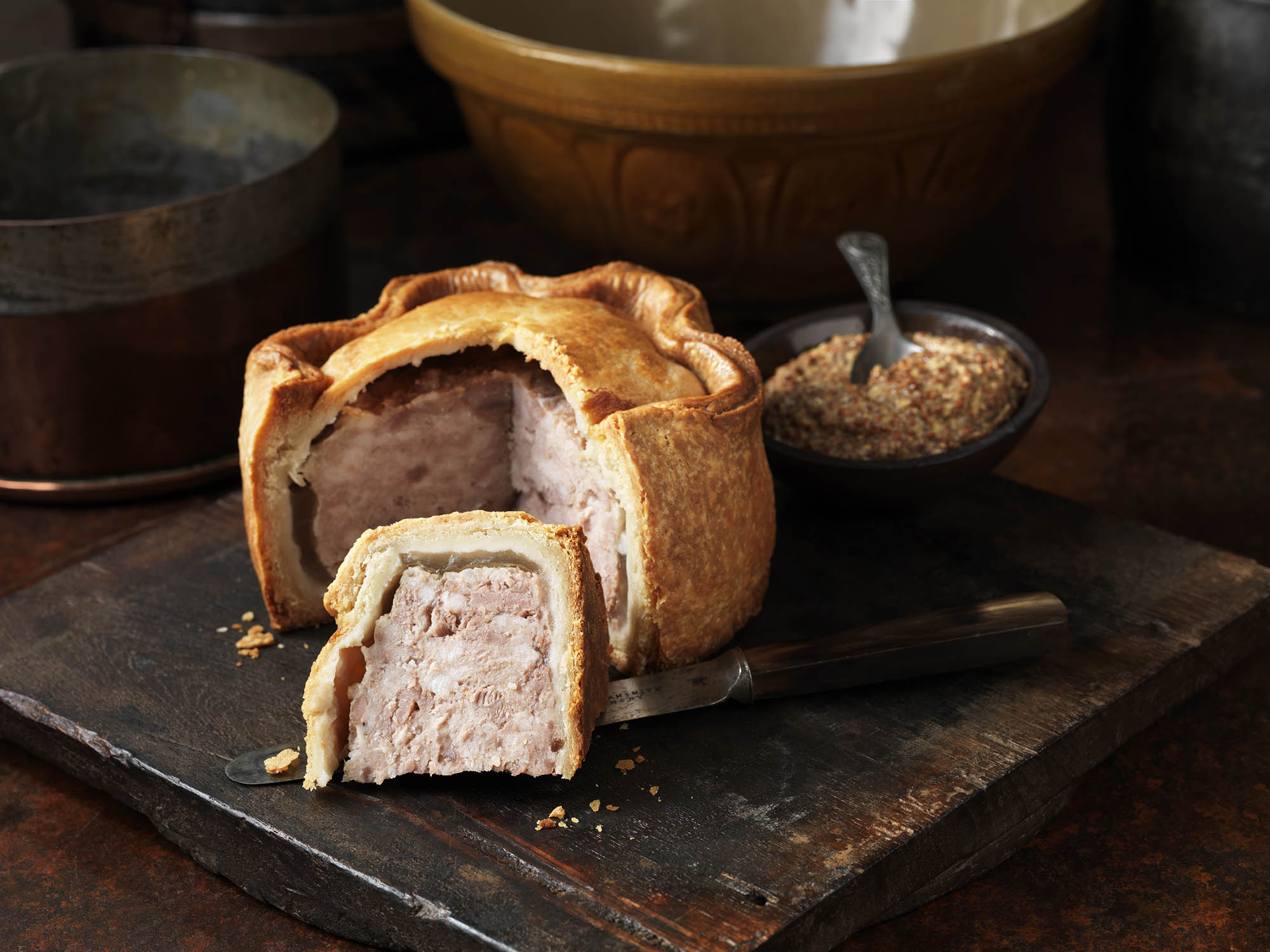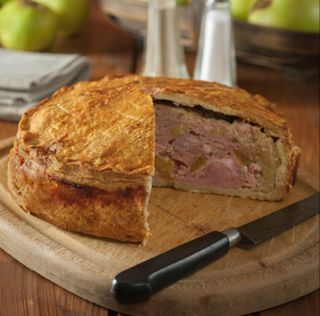Curious Questions: Why is the pork pie associated with Melton Mowbray?
Martin Fone tells the tale of a true British culinary classic: the pork pie.


A staple of the picnic hamper, a satisfying meal on its own, portable, and a perfect accompaniment to a salad, the pork pie is firmly established as one of Britain’s favourite pies. We spend more than £165 million a year on them, according to Kantar Worldpanel. Familiar fare it might be, but the pork pie had a long, fascinating and, at times, contentious history.
An early version of the pork pie appears in De Re Coquinaria, a collection of recipes attributed to Marcus Gavius Apicius, a Roman gourmand living in the first century AD. The ham was boiled with dried figs and three bay leaves. After removing the skin, making diagonal incisions into the meat, and pouring honey over it, it was wrapped in a dough made from oil and flour and served when the dough was cooked (Book VII, IX).
Our forefathers in the Middle Ages were pie enthusiasts. Ominously, pies were known as ‘cofyns’, a term probably derived from the coffin-like casement of pastry complete with lid, but also, surely, a knowing acknowledgement that what was inside was not always of the finest quality. The Forme of Cury (1390) contains a recipe for mylates of pork (XX.VII.XV), a quasi-pork pie with elements of a quiche. The pork was ground, ‘hewe pork al to pecys’, and mixed with cheese and eggs and seasoned with spices and saffron, cheese and eggs, and then cooked in a pastry shell.
It took such a long time to cook the dish that the pastry crusts were rock hard, leading some to wonder whether they were discarded rather than eaten. So integral, though, were they to the recipe that it would seem strange to throw them away. Hannah Glasse’s influential The Art of Cookery Made Plain and Easy (1747), a compendium of 942 recipes, included one for the Cheshire pork pie, a rich and slightly sickly concoction of layers of pork loin and apple, sweetened with sugar and mixed with half a pint of white wine.
Whether this pork pie was a delicacy particular to Cheshire is not clear, but the Melton Mowbray pork pie is incontrovertibly associated with the Leicestershire town. Indeed, on April 4, 2008, it was awarded ‘protected designation of origin’ (PDO) status by the European Commission, since converted, post Brexit, to ‘Designated Origin UK Protected’ or ‘GI, Geographical Interest’ mark. What this means is that only pies made within a designated zone around Melton, roughly ten miles in radius, and in accordance with the town’s traditional recipe can carry the Melton Mowbray name on their packaging.

Grey meat seasoned with salt and pepper, succulent jelly, and bowed walls are the hallmark of a Melton Mowbray pork pie. The meat used is fresh and uncured, which gives it its distinctive grey colouration, in contrast to pork pies made from cured pork, where the meat is pink. The hot water crust pastry is hand-raised which means that the warm dough is kneaded slightly until it is soft and smooth, then fitted around a bottle or wooden dolly, and ‘raised’ by hand, starting from the base, and drawing it upwards to form the walls.
The course chopped pork, seasoned with a little salt and pepper, would then be put into the casing, sealed, and baked in the oven. Made originally without the use of baking hoops, the unsupported pie would sink and bow in the oven, giving it its distinctive shape. Whilst still hot, bone stock jelly was piped in to fill the airspaces within the pie to preserve the meat inside longer, sterilise the contents and give it more solidity, thus reducing the risk of it crumbling when carried.
Sign up for the Country Life Newsletter
Exquisite houses, the beauty of Nature, and how to get the most from your life, straight to your inbox.
Melton Mowbray was a curious nexus of three factors, cheese, pigs, and hunting, that put it at the epicentre of the pork pie world from the 18th century. By this time the dairy farms in the area had concentrated on the production of cheeses, not least Stilton, and one of the by-products of the process was whey, protein-rich and a free source of food for livestock, especially pigs. Willing to eat almost anything, pigs were relatively inexpensive to keep and provided a much-needed source of protein in rural communities. When the supply of whey dried up in the winter, the pigs were slaughtered, and, as there was no need to preserve the meat, uncured pork would go into the pies that labourers ate.
Three local fox hunts, Quorn, Cottesmore, and Belvoir, based their operations around Melton and the huntsmen must have seen the local grooms and servants tucking into a portable pie that seemed almost indestructible. Although a local hunting correspondent thought in 1872 that it was unlikely that ‘our aristocratic visitors carry lumps of pie with them on horseback’, so ideal were they for eating on the hoof that the huntsmen’s provision bags must have included them.
The secret of the pork pie was out. The aristocratic huntsmen could not get enough of them, insisting that they be served for breakfast, and news of the local delicacy reached London’s clubland. Spotting a commercial opportunity, in 1831, Edward Adcock was the first to supply the capital with Melton Mowbray pork pies, sending them down on the daily Leeds to London stagecoach.

In northern England, they have their own version of the pork pie, the ‘Growler’, a name said to refer either to the anticipatory rumble of a tummy just before eating one or the noise the stomach makes after consuming it. They are slightly smaller than the Melton Mowbray pork pie with moulded cases and a distinctive crimped lid. Made from cured pork, the meat is pink, which aficionados claim gives the pie a hammier flavour.
Regional and generational preferences have fuelled a debate as to how the versatile pork pie is best served. Should it be warm, fresh from the baker’s oven, served with mushy peas or is it better at room temperature with either a dash of brown sauce to the side or pickles or mustard? Should the jelly be removed carefully so that the meat can be enjoyed in its unadulterated state or left to bring another flavour profile to the pie? Should pork pie be eaten for breakfast on Christmas Day, an East Midland tradition, fervently embraced by the family of D H Lawrence? And are pork pies with flavoured toppings and stuffed with exotic ingredients beyond the pale?
The passion a pork pie can rouse in some is evident from the website of the Lancashire Pork Pie Appreciation Society (LPPAS), established to appreciate the very best pies the county has to offer. ‘For a pork pie to be worth its name, it must consist of CURED pork’, it bellows. ‘On no account will insipid pies, using uncured pork, such as the Melton Mowbray pie, be considered. There is a disturbing trend towards the appearance of the ‘artisan’ pie. In the pie world, artisan is merely code for expensive. Pies must be affordable in order to be acknowledged by the LPPAs’. Less bellicose but equally as fervent are the members of the Pork Pie Appreciation Societies of Rutland and Yorkshire. Gamely fighting their corner in this melting pot of emotions is the Melton Mowbray Pork Pie Association.
One thing is certain; pork pies have come a long way from being often the only foodstuff to be found in a public house, sitting uninvitingly in a Perspex container on the bar. With vegan traditional no-pork pies now available, there is one to suit every taste and pocket.

Tom Kerridge's perfect picnic: 'I'm a big fan of cold meats and cheese'
This picnic is ideal for the rugby international.

10 of the best British pies, from the Scotch to the Stargazy
Pies are a great British culinary tradition – but what they consist of varies enormously depending on where you are. Flora
-
 Quiz of the Day: Rick Astley's breakthrough hit, Picasso vs. Van Gogh and guess the country house price
Quiz of the Day: Rick Astley's breakthrough hit, Picasso vs. Van Gogh and guess the country house priceHave a go at our Quiz of the Day. Good luck!
By Toby Keel Published
-
 A wetsuit room, fingerprint entry and coastal views from all the principal rooms: Is this the ultimate Cornish holiday home?
A wetsuit room, fingerprint entry and coastal views from all the principal rooms: Is this the ultimate Cornish holiday home?Sitting pretty overlooking Polzeath Beach in North Cornwall, Megizzy’s spectacular views, contemporary design and well thought out features are hard to beat.
By Annabel Dixon Last updated
-
 Curious questions: Why do we use Seville oranges to make marmalade?
Curious questions: Why do we use Seville oranges to make marmalade?Why do we use Seville oranges to make marmalade when there are more than 400 other varieties available worldwide? And do they really make the best preserve? Jane Wheatley investigates.
By Jane Wheatley Published
-
 Mince pies really did once contain meat — and this Victorian recipe will convince you that they should to this day
Mince pies really did once contain meat — and this Victorian recipe will convince you that they should to this dayOnce packed with meat, such as ox tongue and mutton, alongside dried and candied fruit and extravagant spices, the mince pie is not what it once was — and food historian Neil Buttery says that's made them worse.
By Neil Buttery Published
-
 Curious Questions: Margarine used to be pink — but why?
Curious Questions: Margarine used to be pink — but why?Margarine has been a staple of our breakfast tables for over a century, but it hasn't always had a smooth ride — particularly from the dairy industry, who managed to impose a most bizarre sanction on their easily-spreadable, industrially mass-produced rival. Martin Fone explains.
By Martin Fone Published
-
 Curious Questions: Wine has been made in Britain for over 1,000 years — so why have we only just turned it into an industry?
Curious Questions: Wine has been made in Britain for over 1,000 years — so why have we only just turned it into an industry?With the UK wine industry booming, Martin Fone takes a look at its history.
By Martin Fone Published
-
 Curious Questions: What is mock turtle soup? And did it come before or after 'Alice in Wonderland'?
Curious Questions: What is mock turtle soup? And did it come before or after 'Alice in Wonderland'?Martin Fone delves into the curious tale of an iconic Victorian delicacy: mock turtle soup.
By Martin Fone Published
-
 A game of two halves — how the sandwich went from humble fare to a country-wide lunchtime obsession
A game of two halves — how the sandwich went from humble fare to a country-wide lunchtime obsessionWhat started life as a way to eat and play cards at the same time (so the story goes) is now the lunch of choice for the working world.
By Emma Hughes Published
-
 Where to find the world's best club sandwich — and the story of this triple-layered paean to poolside delight
Where to find the world's best club sandwich — and the story of this triple-layered paean to poolside delightThe club sandwich, arguably the most famous of all sarnies, is a poolside staple, but its origins are tricky to trace, says Tom Parker Bowles.
By Tom Parker-Bowles Published
-
 Curious Questions: Why do we eat hot cross buns at Easter?
Curious Questions: Why do we eat hot cross buns at Easter?Annunciata Elwes traces the curious history of the hot cross bun in Britain.
By Annunciata Elwes Published